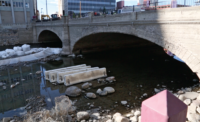Low and Slow: Rocky Mountain Rail








Recovering from recession, rising costs and reorganization, Denver's FasTracks is heading into a milestone year. Officials with Denver's Regional Transportation District (RTD) anticipate the debut of more than 40 miles of new commuter-rail service and 10.5 miles of new light-rail service as part of its $5.5-billion, 122-mile program. The progress is the fruit of strengthened alliances with neighborhoods, developers, other transportation agencies and the contracting industry—including the nation's first transit-related public-private partnership.
Perhaps the most iconic symbol of the FasTracks program, which voters approved in 2004, is Denver's downtown Union Station. The $500-million effort to transform the mostly unused historic train station into a gleaming multimodal transportation and retail hub, completed last year, already has resulted in a boom of real estate development. High-rise residential and office buildings are swiftly growing up around it. A new boutique hotel, trendy restaurants and shops inside the station appeared to be doing brisk business when ENR reporters visited Denver in May as part of its "Low & Slow Across America's Infrastructure" tour.
Three years before the 2004 ballot initiative passed, Cal Marsella, former RTD general manager, initiated the plan to buy 19.1 acres of land in and around Union Station. "Many people thought RTD was crazy," recalls Pauletta Tonilas, until recently the FasTracks spokeswoman.
Downtown Hub
The Union Station intermodal hub includes 22 bus bays built along a 1,000-ft-long hall about 25 ft underground. The canopy-sheltered areas above the bus concourse include space for both Amtrak and Colorado Dept. of Transportation services. Newly completed platforms await the new commuter rail lines that will begin operation next year. The station's 10,000 daily users are expected at least to double.
"There were tumbleweeds at Union Station" just a few years ago, notes Rick Clarke, former assistant general manager of capital programs for RTD. Where once RTD had to sell the transit-oriented development concept to regional officials, he adds, "now cities want transit. Boulder and Longmont want us there."
So does the city of Lone Tree, south of Denver. Last year, RTD agreed to a $207-million, 2.2-mile extension of its existing Southeast light-rail project after local partners contributed $40 million in funding. The extension will reach a development called RidgeGate. The developer, Coventry Development, will provide land for right-of-way and three new stations at no cost, according to a release from the city of Lone Tree. The extension is expected to lead to a $700-million increase in assessed property values.
"It's a public-public-private partnership," says Tonilas. "It's an example of the way we have to think moving forward." It is the way FasTracks officials have had to think over the past 10 years, as project costs exceeded expectations while revenue did not.
Lessons Learned
When Phil Washington replaced Marsella as RTD general manager in 2009, the original cost of the $4.7-billion program had gone up, while tax revenue had dropped significantly during the recession. Residents in Boulder and other communities northwest of Denver were roiling over the lack of progress on the planned Northwest rail line. Washington directed the creation of a transparent "lessons learned" document to guide future transit planning and help to boost team morale at RTD (ENR 1/27/13 p. 48).








